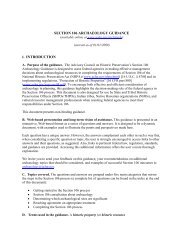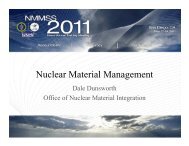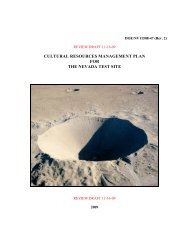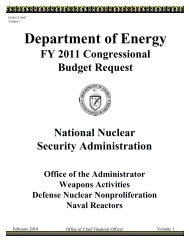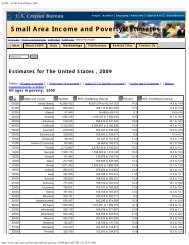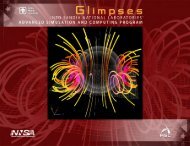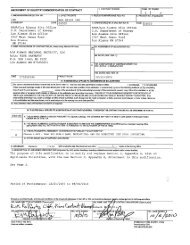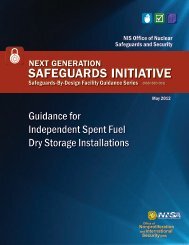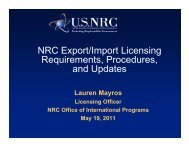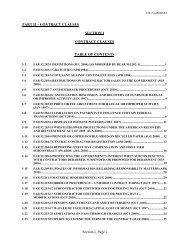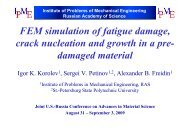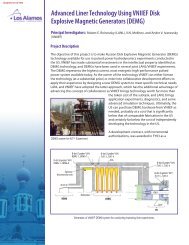ASC Code Strategy - National Nuclear Security Administration
ASC Code Strategy - National Nuclear Security Administration
ASC Code Strategy - National Nuclear Security Administration
Create successful ePaper yourself
Turn your PDF publications into a flip-book with our unique Google optimized e-Paper software.
1. Advance world-leading predictive science, providing the capability to sustain stockpile stewardship without<br />
returning to underground nuclear testing as weapons age and we move further from the test base.<br />
2. Enable Quantification of Margins and Uncertainties (QMU)-based certification, transforming the broader<br />
certification process to allow more effective and selective use of aboveground experiment (AGEX),<br />
certification tests, flight tests, and other tests.<br />
3. Catalyze a responsive infrastructure through pervasive simulation across all aspects of the stockpile<br />
lifecycle, such as design, certification, manufacturing, Significant Finding Investigation (SFI) resolution,<br />
transportation, security, safe dismantlement, outputs and environments, etc.<br />
4. Enable a broadened national security mission, in which simulation tools extend beyond stockpile<br />
stewardship and enable the next-generation mission of the Complex.<br />
This strategy maximizes the impact of the <strong>ASC</strong> Program on stockpile certification, addresses the four objectives<br />
given above, helps to manage the risks associated with upcoming programmatic and technical challenges,<br />
and ensures the continued relevance and effectiveness of the program into the future. The strategy is strongly<br />
aligned with the SSP strategic direction and the <strong>ASC</strong> strategic vision as defined in the 10-year <strong>ASC</strong> <strong>Strategy</strong> and<br />
the <strong>ASC</strong> Roadmap. The strategy clarifies the needed direction and approach for IC and defines a path towards<br />
its implementation.<br />
The <strong>ASC</strong> <strong>National</strong> <strong>Code</strong> <strong>Strategy</strong> rests on three major strategic components to help it achieve its four objectives:<br />
1. Establish the <strong>National</strong> Simulation Portfolio for Weapons Science and Engineering, and<br />
Stockpile Certification.<br />
This strategic component defines a core simulation capability portfolio, consisting of seven modern application<br />
capabilities across six broad application areas, representing a consolidation of the current state of some 14 <strong>ASC</strong><br />
and legacy codes. This component also includes ending development funding for legacy codes, a generalized<br />
capability to couple the various national code capabilities, and additional consolidation in the area of setup<br />
tools. The <strong>National</strong> Simulation Portfolio consists of the following:<br />
Three Major Validated, <strong>National</strong>, Integrated, Full-System Capabilities<br />
2 national nuclear performance systems, spanning primary and secondary performance, to provide peer-reviewed weapons performance assessment<br />
1 national non-nuclear assessment system, spanning core simulation capabilities needed for stockpile lifecycle, including manufacturing and<br />
engineering certification<br />
Four <strong>National</strong> Integrated Capabilities for Specific Applications<br />
1 national nuclear explosives package (NEP) safety capability<br />
1 national high energy density physics (HEDP)/ inertial confinement fusion (ICF) capability<br />
1 national Radiation Effects capability for electrical systems<br />
1 national diagnostics capability<br />
2. Advance Computational Algorithms to Enable Predictive Simulation and QMU.<br />
This component focuses on enhancing the scalability of underlying computational methods to peta and exa<br />
scale computing, collaborating on programming models for petaFLOP and exaFLOP scale computing, and<br />
delivering advanced capabilities for QMU and uncertainty quantification.<br />
3. Broaden the Impact of <strong>ASC</strong> Simulation Capabilities on <strong>National</strong> <strong>Security</strong>.<br />
This final component addresses the objective of broadening <strong>ASC</strong> impact through outreach, development, and<br />
support of interagency partnerships, and enhancing capabilities for expanded national security missions.<br />
These major strategic components will be explained in detail, with specific defined goals or activities for each of<br />
2v



